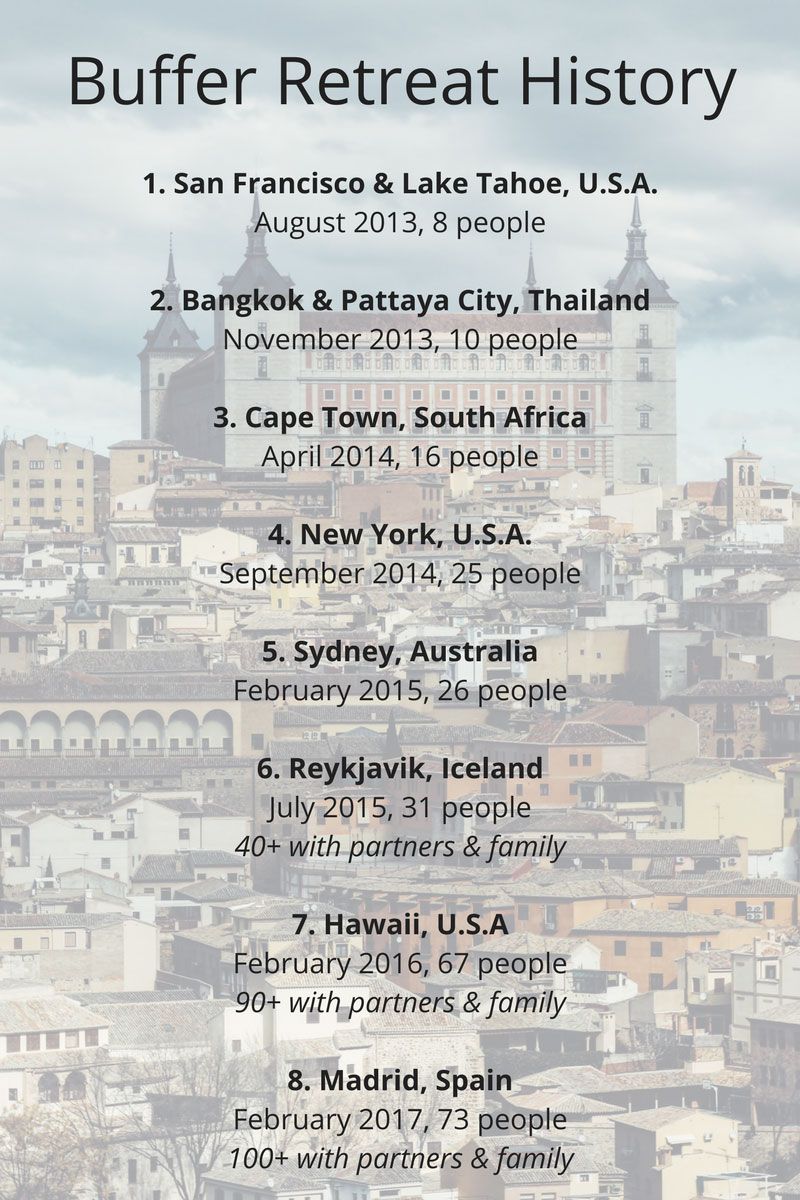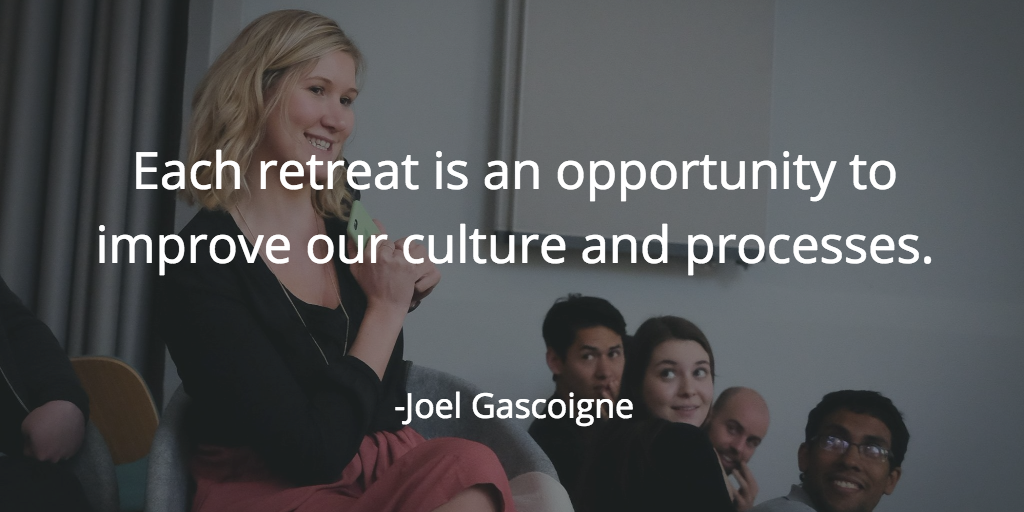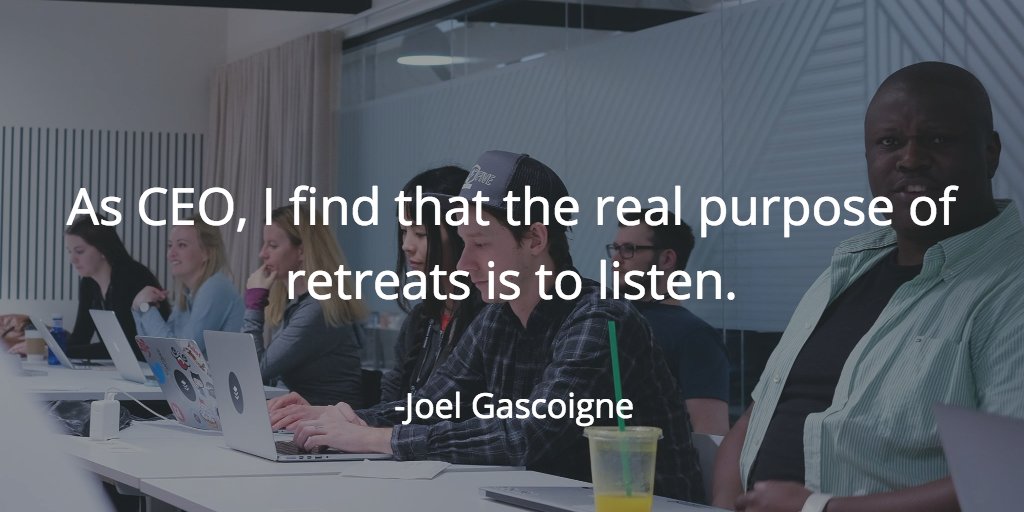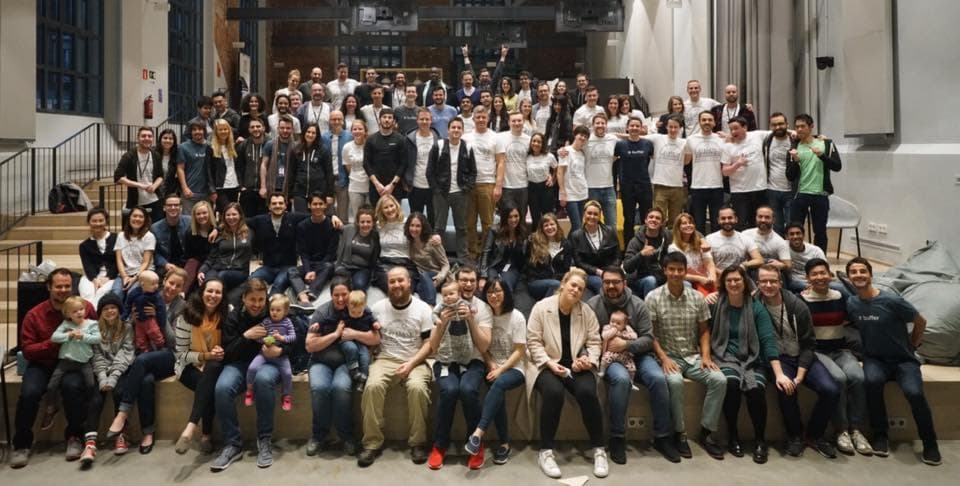By now we have a fairly long history of doing retreats at Buffer. We’re now a team of 75 who all work remotely, and we just wrapped up our eighth company retreat in Madrid, Spain.
Here’s a quick history of retreat locations, timeline, and size over time:

It’s been a wild ride for us at Buffer, and the regular company retreat is a very clear part of our culture. Each retreat has felt a little different, and the nature of the retreat evolves as the company grows and as our vision and culture advance.
The purpose of retreats, from a CEO perspective
As CEO of a 75-person remote team, I see the retreats as an essential part of the work we do together. I firmly believe that if we would operate the company without these regular face-to-face gatherings, we would be less effective and feel less connected.
When we were a team of less than 30 people, the retreats felt like they could be a productive day-to-day work time for us, a shift towards working together, but continuing with the projects we happened to be working on. In addition, when we were smaller, we would do the retreats more regularly (around every four to seven months). By doing them more frequently, and having a smaller team, the retreat itself was not as much of a monumental event because it would come around again quite fast. Today, we have fewer retreats: This retreat was one year after our last one in Hawaii.
As a result, today our retreats serve less of a purpose of immediate productivity and are more geared towards long-term productivity and meaningful connectedness of the team. We focus all of our sessions throughout the week on brainstorms and higher-level discussions that will have an impact for months going forward.
As CEO, I find that beyond the opportunity I have to provide leadership, set vision, and create alignment, the real purpose of retreats is to listen.
I try my best to float in and out of different groups, whether for lunch or dinner, in sessions during the day, activities on off days, or drinks in the evening. In these very different groups, I am part of the conversation but also sitting and listening and trying to take a lot in. Of course there will always be blind spots for me as a leader, so I lean on the leads I work with. I also try my best to be present and soaking up the joys and frustrations that I hear expressed. Each retreat is an opportunity to take this in and try to act to improve our culture and working processes further.

Timing of a retreat
The context within which a retreat happens is a key component of how it will feel and the goals we try to have in mind.
The past 12 months since our last retreat have been difficult at Buffer. We had layoffs in June, and in January, my co-founder Leo and I came to the conclusion for him to move on from Buffer. Our CTO Sunil also decided to leave the company at this time.
It was a lot of change for a single year. It’s been rocky. We’re now in a great position and have rebuilt our cash reserves to over $2.4m since the low point of $1.3m around our cash flow crisis.
As a result, at retreat it was important to acknowledge the past year. Morale is still in recovery from those ups and downs, and the team gathering in Madrid could not have come at a better time. We had sessions in which people could open up about those feelings, and we also had a lot of serendipitous conversations around the future.
All in all, I think we did a good job of acknowledging the challenges and also sharing the excitement with each other about our future. We shifted towards this throughout the week, and almost all teams focused on their vision for 2017. I shared a lot of my own ideas around the company and product vision going forward, and we have a huge number of opportunities based on our solid foundation of products, customers, culture, and profitability.

Being a key part of retreat as an introverted CEO
I am lucky to have an incredible team I work with on retreat, and this year our operations manager, Stephanie, really took on the task wholly, and I didn’t need to be too involved in the planning. At the same time, I am leading the retreat in many ways. For example, I kick the retreat off, and run many of the sessions. Especially since retreats are not cheap, our budget for Madrid was $400,000. I strive to reflect on how we get the most out of the time and take a lot of personal responsibility for that.
The retreat itself is a week packed with so much energy and happiness. We are all incredibly excited to see each other after a year apart, and this year around 25 people were on retreat for the first time, meeting almost all the team for the first time.
I am an introvert, around 85–90 percent introvert versus extrovert in most tests I take. In the past, this has at times led to debilitating situations after long periods of social stimulation. Around four to five years ago, I started to understand myself much more clearly, and I now find in general I can take the action I need to in order to feel recharged most of the time.
During retreat, I took a a 20- to 45-minute solo walk each day. At an appropriate time in the afternoon between sessions, I’d just head out of our work space and go walk up the nearby hill. After a day with a lot of social interactions, my mind can feel clouded, and I find it hard to think and articulate clearly when I am drained. It’s always fascinating to me how quickly I can recover from this and feel energized, sharp, and ready to be amongst people again. A few times when this was essential was before my fireside chat with the Madrid community at Google Campus, before our Sunday welcome drinks, and before our Wednesday evening team dinner.
I have found that it absolutely is possible for me to enjoy the whole week, as long as I remember to be aware of my energy levels and take care of myself.
It’s been a hugely rewarding and energizing week. I am pumped for the rest of 2017, and I am confident we’re going to achieve some great things together. If there’s any single takeaway for me from the retreat, it is the reminder that I get to work with the best team on Earth.
Try Buffer for free
190,000+ creators, small businesses, and marketers use Buffer to grow their audiences every month.




